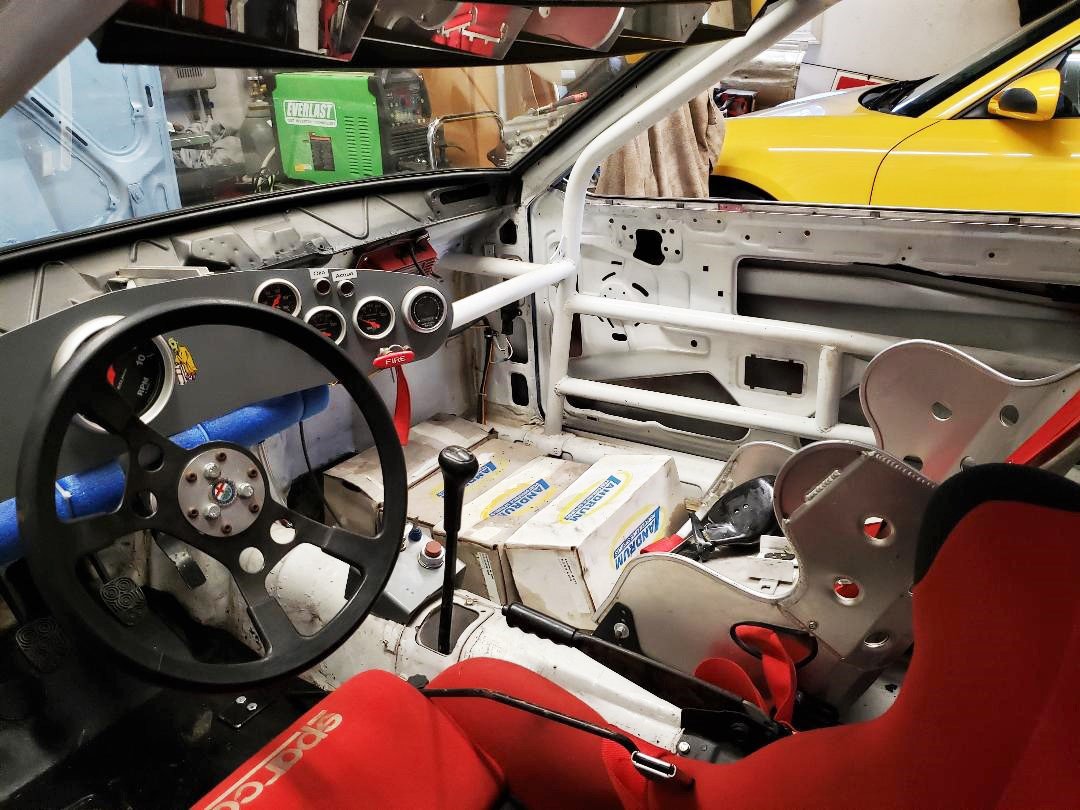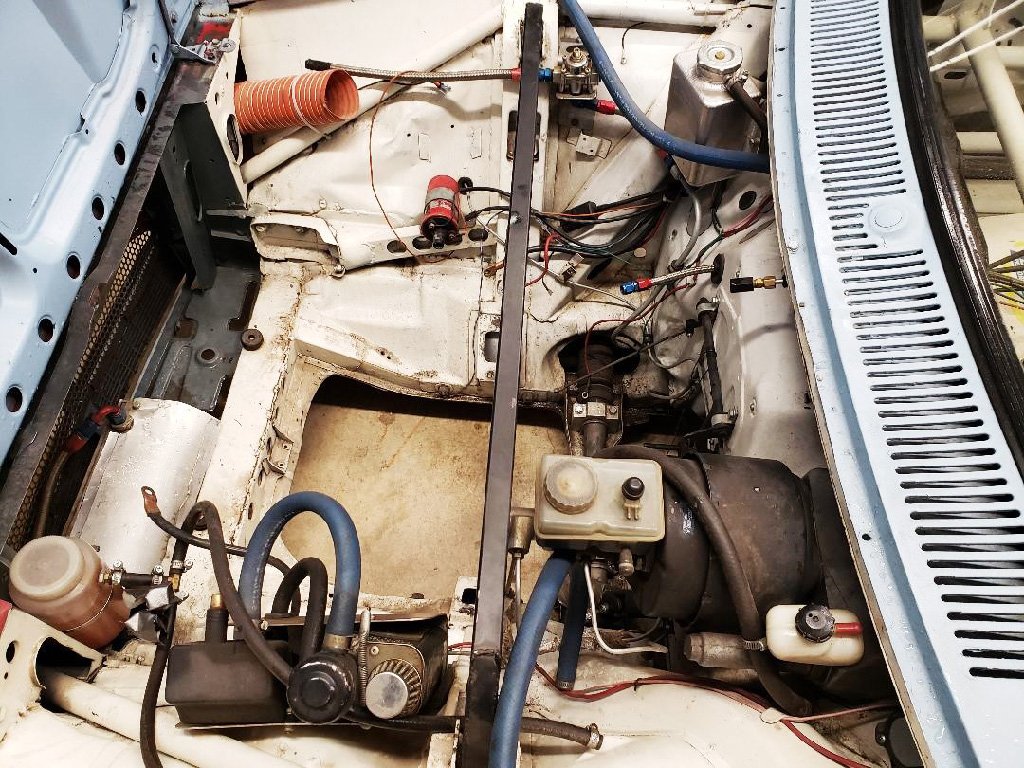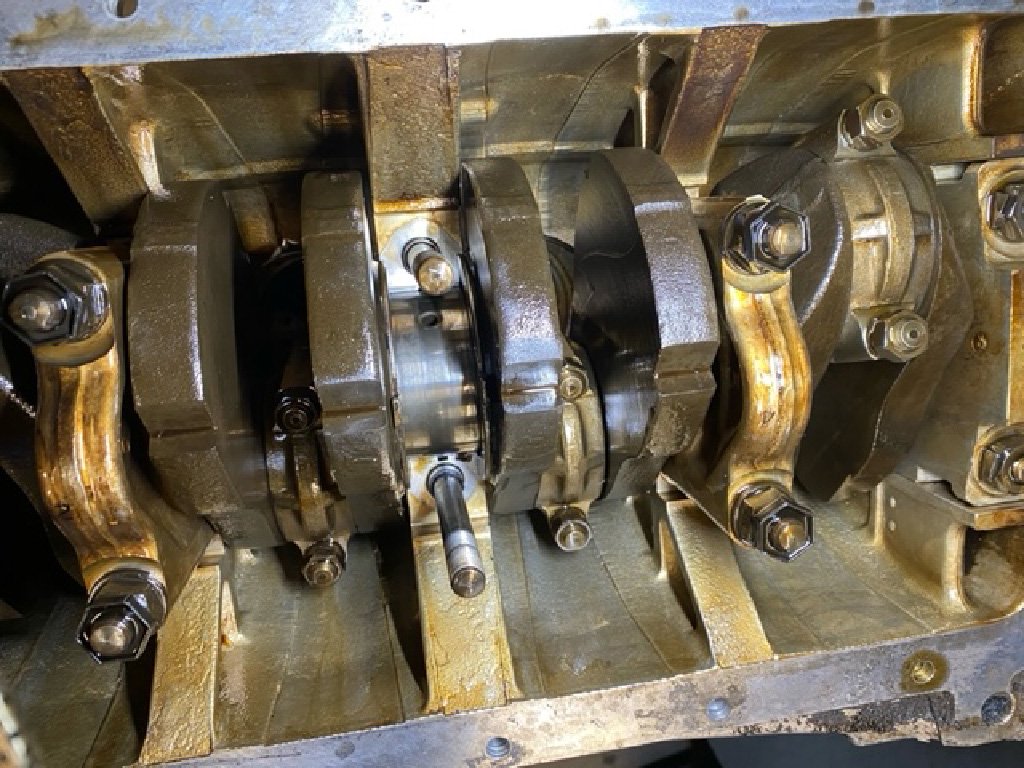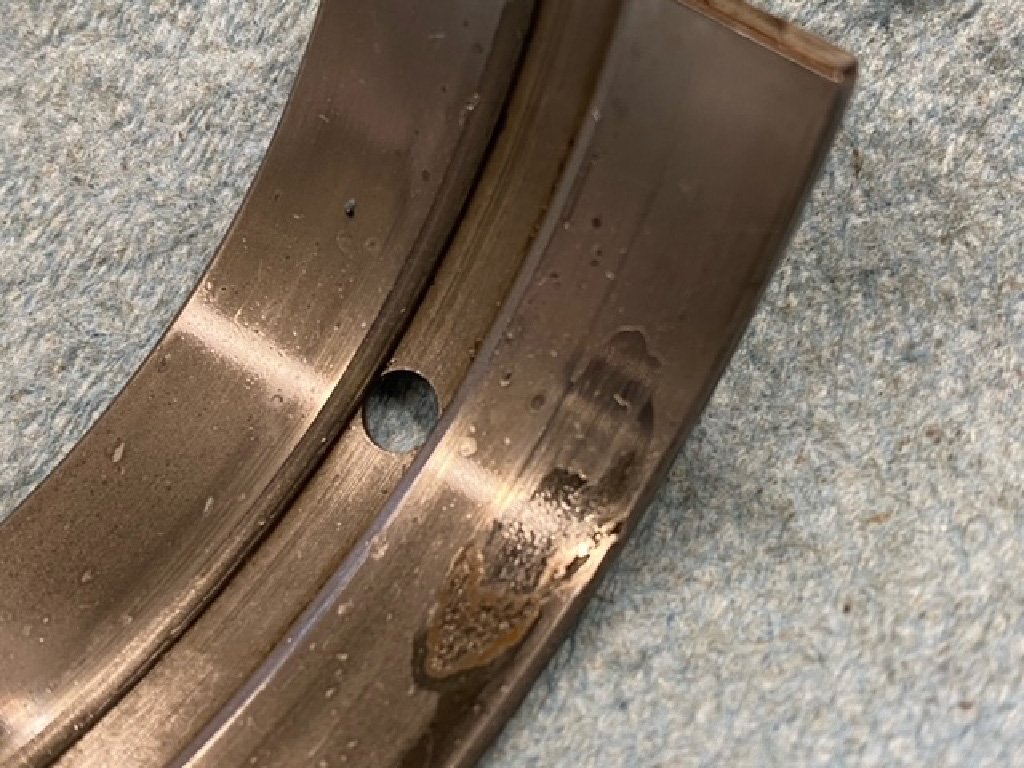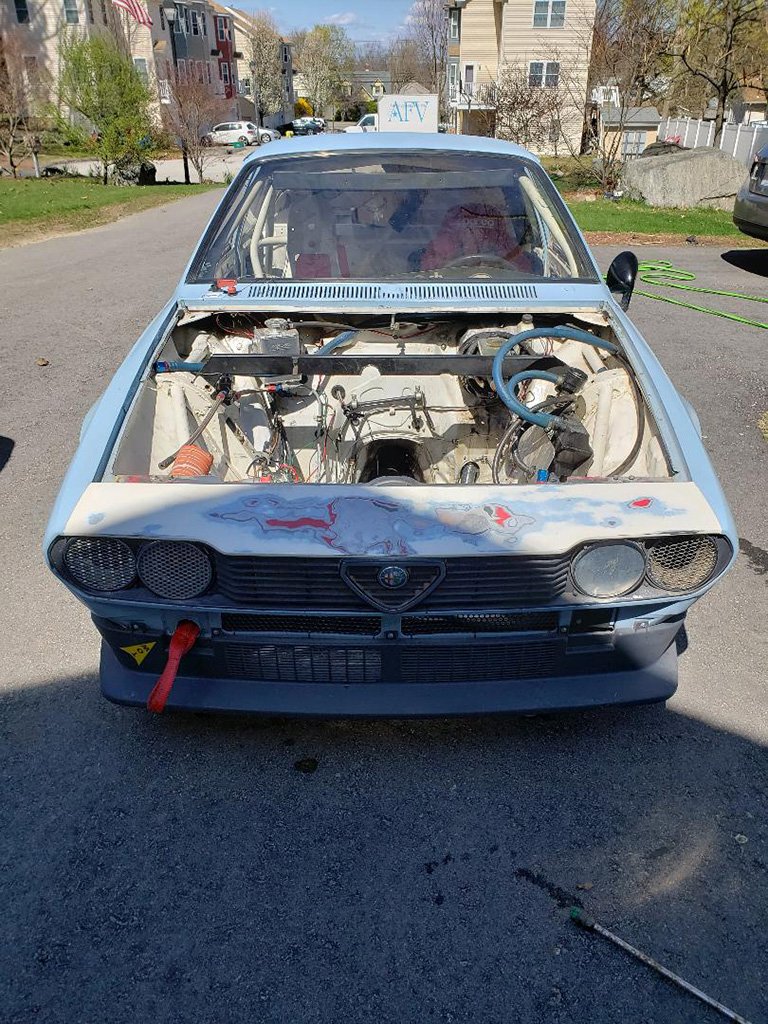Racing an Alfetta
Part 1
IT ALL STARTED LAST SEPTEMBER at the “Alfas at the Glen” vintage race weekend at Watkins Glen. I was there, supporting (well, that’s what I told my wife, anyway) my various friends with their Alfas, but mostly just enjoying myself. Greg Seferian was there with his blue Berlina. Nick Fonte was there with his ‘75 IMSA Turbo Evoluzione and his SCCA EP GTV6. Mike Lawton with his ’72 Spider, and a whole lot of other friends and Performatek customers. Also there and helping was our friend Lon Barrett. Lon has been a closeted Alfa guy since 2009, when he joined Brian Shorey’s (AONE, now on the West Coast) 24 Hours of LeMons Milano team. LeMons is where we met Greg with his LeMons Milano team and Kevin Oliver (ex-AONE) with his LeMons Milano team. Lon has been racing Alfas for all this time, first with Brian’s team and then, when Brian went West, with Greg’s Milano (Angelina) team Pro-Crash-Duh-Nation. Let us say that for a BMW/Porsche guy he has spent a lot of time in the driver seat of Alfa Romeo DeDion chassis race cars. His email signature line is “I don’t drive Alfas. I race them.”
Anyway, we were driving around Watkins Glen when out of the blue he asks, “Do you think an Alfetta would make a good vintage racer?” Sheesh — how do I answer that one? I mean, I like Lon. “Hmmmm, well, if you don’t care about running at the front of your class, it would be an excellent vintage racer,” says I. “It is a little heavy compared to the 105 cars running the same 2.0L engine (although one could argue with superior handling), but that weight differential is HARD to overcome. The worst ‘sin’ is that there is no cheating headroom. Hell, the 240Z guys are all running 3-3.5L engines; same for the 510 guys, running 4 cyl engines punched out well past 2L. Lots and lots of that going on. There is no meaningful way to stretch a 2.0L Alfa engine. Only way to do it would be to run a V6 which also has negative consequences. You sometimes might run in same class as the Alfettas and 105s, but oftentimes the organizers will throw you in with the V8s and 911/930 Porsches, so you end up in the same relative place, only this time with no one to race against. If you are happy to run your race, find someone in the pack to race with, it will be a hell of a good racer. The price of entry is waaaay lower than buying a GTV. You have hours and hours of race time in this chassis. You have a bunch of experienced and very good friends racing DeDion chassis. It would be a good fit.”
After a little time, Lon told me that he had decided to try it. I hooked him up with a customer in New Mexico who had built just such a car to run in a nascent vintage group out there, but the group had petered out and the car was for sale pretty reasonably. It was missing an engine, but it had been a New Mexico car its whole life, and a race car for most of it. It has ALL of Performatek’s suspension gear in it, a full cage, race wheels and tires, fire system, fuel cell, aluminum radiator, oil cooler, yada yada. Most of all, it was a race car, not some rusty bucket that had to be stripped of road gear, all the rust repaired and then turned into a race car. It had had several seasons of racing in its current iteration so it was pretty well sorted. Lon jumped and the Alfetta showed up in January. At this point, I was starting to feel R-E-A-L-L-Y guilty — after all, he has no real background in nitty gritty Alfa-ness. I did not want to leave him all alone on Alfa Island. I decided to pitch in and do my best to help with the work and get him started on the Alfa Way. Plus, it would be fun.
Lon had decided to make a VRG Licensing school and race weekend in May at Summit Point. Two days of school leading into 4 days of racing. A deadline is good for motivation. Now the clock was running on the project, TICK TOCK.
Plan A: Just get a running street engine in the car, check it over, fix what needed to be fixed, and maybe even get a track day in to see what breaks. Get to Summit, keep the revs under 6K, run the school and the first race event — get those items checked off in his log book. Then worry about a real engine. Seemed like a reasonable plan — HA-HA-HA.
While we looked for a running Alfetta engine, we started sorting things out — what came with, what was needed. The car came with an Alfetta sump and Alfetta headers. No engine, Alfetta or otherwise. Well, an engine would be a good place to start, but it turned out to be impossible to find a running Alfetta engine that did not come with an Alfetta attached. He managed to find a totally unknown Alfetta engine for sale in Springfield — just a greasy lump on a pallet with a tag on it that said “strong”. Nice. It had its SPICA, and Lon’s initial intent was to race a SPICA engine. But the more we considered it, the less likely it seemed a sensible approach. Also, there was no flywheel on it (or front donut — which donut does it take?) — a real problem, as it turns out. No starter, no alternator. Yeah.
We decided to hook up a starter just to turn it over, to see if it WOULD turn over without clunks and screeches and if there was some hint of compression. With the engine on the garage floor, we mickey-moused a starter and, lo and behold, it did turn over — slowly, but it turned over and made no bad noises. Good compression, on the other hand, not so much — ranged from 15 to 80 psi. A 3rd world leak down test indicated that rings were okay, but the air was just blowing right out the exhaust valves. That’s not good, but better than blowing by the rings. In fact, we took the valve cover off, tappets off and pounded on the valve stems (I said this was a 3rd world exam). And compression went up — not enough but confirmed that valves were the problem! OK, Plan A is officially gone. Time for Plan B — this head is coming off. We’ll check for soundness (cracks, flatness and whatnot), do a razzle-dazzle valve job and pick whatever low hanging fruit is available to us, then throw it back on the stock bottom end, ‘cause, TICK TOCK.
Our friend (and fellow DeDion racer) Nick Fonte jumped in with lifesaving hardware loans and actual help. Flywheel, carbs and manifold, set of cams — pretty much everything that we needed to get this thing turned around.
In the meantime, while parts accumulated, Lon did lots and lots of cleaning. You know what is good? Pressure washing an empty engine bay and greasy lump engine — that is what is good! So much progress, so little time (or effort) required!
We opened the bottom end. It was clear that someone had been in this thing before. However, the bearings looked acceptable, so that was good. All cap nuts were tight. We increased preload on the oil pump relief valve to increase oil pressure. Installed a lightweight, powerful Denso starter and alternator (courtesy of Performatek). Repaired a never-ending list of to-dos. Fabricated a bunch of plumbing, a homemade Spica block-off plate that actually worked, sorted a bunch of electrical issues. Fabricated and installed the critical cooling water diverter into the block. Early 2.0L engines had this cast into the block, so as the coolest water came directly from the radiator into the block, it was diverted immediately to the cylinder head to give max cooling there. Later engines (i.e. post EPA) did not have this diverter. It was left out specifically to increase the rate of warming in the head so that they could meet EPA regs. Good for EPA, very, very bad for racing. This new diverter restores that cooling.
One little-known or appreciated joy of matching stock components to custom other stuff is that parts books and the usual Alfa parts suppliers are of very little use. Why did the last owner do this? It looks weird, do we have to do that? Will this hose go from manifold inlet to the not stock radiator? No? What hose do we need? What about this oil breather doodad? Etc, etc.
A lot of late nights, and now the Amazon driver can get to Lon’s house blindfolded.
Once all the head rebuild parts came in, we took the car (with block installed) to Nick’s. Nick and Lon cut high-performance valve seats (including making the intake seats bigger for the new 45mm intake valves — I told you this was quick and dirty). We installed all the new valves & hardware, and then the cams. They are Alquati 306 cams with 11mmm lift and fairly modest duration. They are not much but they work well with the low stock compression, are a definite improvement, and they juuuuuust fit into the cam galleys without any modification. Installed the head, got the headers sorted & installed. Installed the new Bluetooth programmable 123 distributor with a known good ignition curve. Set the rev limit to 6,300 RPM. Now all we had to do was install the carbs and fire this bad boy up! By this point we are about 5 days from departure. TICK TOCK.
Install the carbs … it seems so easy when you say it like that. Turns out getting them sorted (glossing right over this to save the pain of having to recall the events!) and connected to the racing fuel system, was a little circuitous, but in the end they were good to go. Then, after about four evenings resulting in false starts (you should pardon the expression), it was Friday before departure on Tuesday, and we are ready for sure —it has to fire now! All excited, a celebratory bottle of Prosecco on ice, “Hit It!”. Lots of cranking, but no joy! Double check ignition advance, it coughed a little, and then idled reasonably smoothly a little. But when you whacked the throttle open, the engine would quit like someone had hit the kill switch.
Now, it’s Friday night with departure Tuesday morning and the thing is NOT running … TICK TOCK. As I was driving home, it occurred to me that Lon had never even driven the car, and all of a sudden things seemed much worse than before. This promised to bring an exciting week —or more correctly a mad scramble for three days. Soooo many untried things. One big worry was driveshaft balance, but the “complete” list was endless.
Finally, on Saturday, we figured out that the original distributor (oil pump really) had been put in backwards (I told you someone had been in this engine before —maybe we got lucky and they put in a set of Motronic pistons???). When we installed the new 123 distributor, it seemed seated in the drive, but it was not. So, the timing was 180° out and when we whacked the throttle open, the drive gear just spun past the distributor drive … and death. Once that was sorted, it did in fact fire right up, idled and made a ton of smoke! I mean A TON!. After a day or so of running, it did clear, but took a long time, and the car still makes a little smoke when running. But what a relief — joy, even.
The First Start (crappy low-res video)
So, the car was “ready” on Sunday before departure. However, Lon still had a day and a half of prep and trailer loading to make the trip. Still, the only driving it had done was up and down the driveway and then up into the trailer. TICK TOCK.
I arrived at 6am Tuesday morning for the long drive to West Virginia and the beginning of a whole new adventure.
THE VRG HAS AN INTENSIVE SCHOOL to prep drivers for their race licenses. No matter your background, they assume you know nothing and start from basics. They interleave classroom sessions with practical lessons on basic track technique, like threshold braking, slalom, etc. These exercises give the instructors a good opportunity to see what the cars’ prep levels are, see what the drivers’ abilities/experiences are, and at the same time teach the students to be attentive to issues like car balance and weight transfer. There were also sessions of riding in instructors’ cars (in this case, Dodge Charger Hellcats, which was a shock) on the autocross pad while the instructors go over some of the finer points of car control. All I know is that, when it was over, Lon came out of the car with his eyes bugging out. “Holy crap, that old man can drive! What an eye-opener, I think I learned more about driving fast in those 30 minutes than I have in all the rest of my track time combined.”
Later, the instructors took the students out around the track in two separate sessions to show them the safe and fast way around the track. First one half of the track, then a classroom session to discuss, then the other half followed by more classroom, finishing with a few complete laps. Later, students went out lapping in their own cars, again under the supervision of instructors. Finally, on Thursday morning, they were sent out in a student only race —in which Lon finished 4th - NICE! After that student-only race, finally, they started racing with the rest of the regular race entry, which was quite big. This schooling went on from 8am to 8:30pm. For me, since I was in a support role, and the car was completely untried, I was running around Summit trying to be available in case something went wrong — which, thankfully, didn’t happen. Frankly, I was exhausted from all the hither and thither! I was so relieved when the actual racing started, my schedule basically became just sit around, then go watch Lon run for 20 minutes. Then sit around some more.
Through it all, the car was damn near flawless. In the first threshold braking exercise, the car got a little squirrely as it came to a stop. A slight change of the bias adjust knob fixed that. The rest of the time, it was just “go fast and have fun”. For extra fun, from Thursday afternoon on, the conditions were quite rainy. It either streamed rain on track or had just done so. Either way gave racing on a swimming wet track. In the first race in the rain, Lon said that in one banked turn, there was a giant (wide and deep) puddle that he had to drive through. “When I hit the puddle, a solid wall of water came up over the hood and windshield, and went right over the roof of the car!”
The Alfetta proved to be quite competent and fast in both conditions. The Alfa’s tweaked street engine was definitely down on power compared to most of the competition, but fantastic handling, chassis balance, road holding and braking made up for a lot of that. Lon got a lot of interest and praise from the instructors (and rightly so). However, I find it interesting that they totally ignored his thousands of race miles accumulated in 24 Hours of LeMons racing! The Alfetta drew a lot of positive interest from just about everybody. I must say it is a rare sight to have a DeDion chassis Alfa at a vintage event. The good news, Lon and the car met their goals: Lon, with new VRG log book in hand, was well on his way for his license and the car made it through the ordeal — completely unscathed.
There was one interesting event: On Thursday and then on Friday, Lon complained that the engine was breaking up at about 5,500 RPM. An odd thing. We checked fuel pressure, fine. Checked ignition timing, spot on. Really, nothing jumped out as needing to be fixed, so we decided to just keep running it as is. If something broke, we'd then know what to fix. As we kept thinking about things, we decided that it felt like the rev limiter had kicked in about 700+ RPM low. So as a gross check, let’s raise the rev limiter on the distributor — set it to 7,500 RPM and let’s see what happens. Hurrah, ran perfectly and pulled hard all the way to an indicated 6500 RPM, no problem! Later we checked the dash (electronic) tach against our timing light tach. Sure enough, the dash tach was registering about 500+ RPM low at high rpm. So that was a relief (nothing to troubleshoot and fix). Only later did it dawn on me that Lon had been running the engine at our actual previous limit of 6500 RPM, and now, was winding up his “keep the revs down unknown quantity beater rebuildable core” engine over 7,000 RPM for the better part of two days and four races. A good, used Alfa engine is a true thing of beauty!
There are still some technical issues to sort, the most pressing being that we definitely need to adjust the jetting for both low RPM and more worryingly the high RPM use. The AFR is horribly rich at low RPM, by 3K leans out to an excellent AFR, and by 5K it starts to go lean and continues to get increasingly lean right up into the power zone, just when you want it to be a little rich.
All in all, Lon is having a ball with this car. Next stop VRG at Thompson the end of June.







